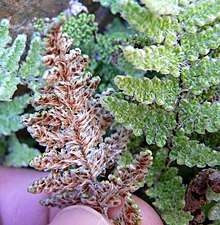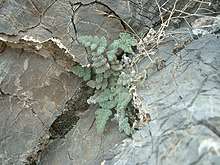Myriopteris
Myriopteris, commonly known as the lip ferns, is a genus of cheilanthoid ferns. Like other cheilanthoids, they are ferns of dry habitats, reproducing both sexually and apogamously. Many species have leaves divided into a large number of small, bead-like segments, the probable inspiration for the generic name. Hairs and/or scales are often present on both the upper and lower surfaces of the leaf, and their presence and appearance are useful in distinguishing between species. The genus is most diverse in Mexico, but species are found from southwestern Canada south to southern Chile, and one species is endemic to southern Africa.
| Myriopteris | |
|---|---|
_(6744464787).jpg) | |
| Myriopteris wootonii, showing the highly-divided leaves and beadlike segments associated with the genus | |
| Scientific classification | |
| Kingdom: | Plantae |
| Clade: | Tracheophytes |
| Class: | Polypodiopsida |
| Order: | Polypodiales |
| Family: | Pteridaceae |
| Subfamily: | Cheilanthoideae |
| Genus: | Myriopteris Fée |
| Type species | |
| Myriopteris marsupianthes Fée | |
| Species | |
|
See text. | |
| Synonyms | |
Description
No single morphological character divides Myriopteris, as presently circumscribed, from the other cheilanthoids. Convergent evolution in arid environments is thought to be responsible for widespread homoplasy in the morphological characters traditionally used to classify this group.[1] While small, bead-like ultimate segments are associated with the genus, they only appear in about 40% of its species,[2] and appear in some cheilanthoids outside the genus as well. Cheilanthes sensu stricto bears 32 spores per sporangium in sexual species and 16 in apogamous species; with the exception of a few species of Notholaena, Myriopteris and the other cheilanthoids bear 64 spores per sporangium when sexual and 32 per sporangium when apomictic. Myriopteris can also be separated from Cheilanthes s.s., although less reliably, by spores bearing crests or wrinkles (rather than spines or bumps) and a lack of enlarged vein endings (rather than prominent hydathodes).[1]
The three subgroups of the genus, informally called the alabamensis, covillei, and lanosa clades, likewise lack unique defining features. The small, bead-like ultimate segments are found in the core subclade of the covillei clade and also in M. gracilis, which is deeply nested in the alabamensis clade.[3] Circinate vernation (the unfolding of new leaves as fiddleheads) is found throughout the lanosa clade and also in M. wrightii, the most basal member of the alabamensis clade.[3] Most species have round rachises, although early-diverging members of the alabamensis and lanosa clades have rachises deeply grooved on the upper surface and flattened rachises shallowly grooved near the frond tip, respectively.[2] Leaf indument (hairs and scales) is highly diverse across the genus and a key feature in species identification.[2]

The base chromosome number for the genus appears to be x=30, except for a portion of the alabamensis clade, where x=29; the latter is typical for other cheilanthoids. Most species are either sexually reproducing diploids or apogamous triploids, with the exception of M. lendigera and some specimens of M. microphylla and M. scabra, which are sexually reproducing tetraploids.[4]
Taxonomy
The genus was first described in 1852 by A.L.A. Fée, who separated it from Cheilanthes proper by the presence of red hairs among the sporangia and a scarious (hardened) indusium formed from the leaf margin. He typified it on Myriopteris marsupianthes. Fée described the division of the leaf into numerous small, beadlike segments, all capable of bearing spores,[5] which may have led him to choose the name Myriopteris; "myrio-" means "very many"[6] and "pteris" means "fern". John Smith recognized Myriopteris in his Cultivated Ferns of 1857, noting the "minute, orbicular or cuneiform, concave" ultimate segments typical of species in the genus.[7] However, most authors until the 21st century preferred to include the genus in Cheilanthes.[8]
The development of molecular phylogenetic methods showed that the traditional broad circumscription of Cheilanthes is polyphyletic. Many of the morphological characters that have traditionally been used to separate the cheilanthoid ferns into genera, including Cheilanthes, are homoplasious; that is, they have appeared independently in unrelated groups, probably as a result of convergent evolution in arid environments.[1]
A molecular phylogeny of 157 cheilanthoid species by Michael D. Windham et al. in 2009 revealed seven well-supported clades within the group. One of these included a number of mostly North American species usually placed in Cheilanthes sensu lato. They informally referred to this group as the myriopterids, Myriopteris being the most senior genus whose type specimen was included in the clade.[9] Further phylogenetic analysis by Eiserhardt et al., in the course of a study on cheilanthoid evolutionary radiation in the Cape Floristic Region, also supported the existence of the myriopterid clade and showed that Cheilanthes rawsonii, an African endemic, was deeply nested in it, its closest relative being C. parryi.[10] After more extensive sampling within the clade, Amanda Grusz and Windham revived Myriopteris in 2013 and provided names in it for all species in the myriopterid clade.[1]
Further molecular studies by Grusz et al. confirmed the monophyly of this group, and showed that its species can be divided among three well-supported clades. These were informally referred to by the epithet of a prominent species in the clade, without formal taxonomic rank; they are the alabamensis clade (A), covillei clade (C), and lanosa clade (L).[11]
The genus Cheilosoria was described by Conde Vittore Trevisan in 1877 to accommodate Cheilanthes allosuroides, now M. allosuroides, and a few other species of Cheilanthes with long sori along the veins and relatively unmodified false indusia.[12] That genus was lectotypified on C. allosuroides by Edwin Copeland in 1947.[13] If the alabamensis clade were to be treated as a separate genus, Cheilosoria would be the senior name for it.[14]
Species
The following species (including two hybrids) are those recognized by Grusz & Windham in 2013, with some additions from the Checklist of Ferns and Lycophytes of the World (version 8.11).[15] Letters in parentheses following the scientific names indicate which of the three clades the species belong to, if known.
- Myriopteris aemula (Maxon) Grusz & Windham (A) rival lip fern, Texas lip fern
- Myriopteris alabamensis (Buckley) Grusz & Windham (A) Alabama lip fern, smooth lip fern
- Myriopteris allosuroides (Mett.) Grusz & Windham (A)
- Myriopteris aurea (Poir.) Grusz & Windham (C) golden lip fern, Bonaire lip fern
- Myriopteris chipinquensis (Knobloch & Lellinger) Grusz & Windham (C)
- Myriopteris cinnamomea (Baker) Grusz & Windham (C)
- Myriopteris clevelandii (D.C.Eaton) Grusz & Windham (C) Cleveland's lip fern
- Myriopteris cooperae (D.C.Eaton) Grusz & Windham (L) Cooper's lip fern
- Myriopteris covillei (Maxon) Á.Löve & D.Löve (C) Coville's lip fern
- Myriopteris cucullans (Fée) Grusz & Windham (A)
- Myriopteris fendleri (Hook.) E.Fourn. (C) Fendler's lip fern
- Myriopteris × fibrillosa (Davenp.) Grusz & Windham (C)
- Myriopteris fimbriata (A.R.Sm.) Grusz & Windham (A)
- Myriopteris gracilis Fée (L) slender lip fern
- Myriopteris gracillima (D.C.Eaton) J.Sm. (C) lace lip fern
- Myriopteris intertexta (Maxon) Grusz & Windham (C) coastal lip fern
- Myriopteris jamaicensis (Maxon) Grusz & Windham (C)
- Myriopteris lanosa (Michx.) Grusz & Windham (L) hairy lip fern, woolly lip fern
- Myriopteris lendigera (Cav.) Fée (C) nit-bearing lip fern, beaded lip fern
- Myriopteris lindheimeri (Hook.) J.Sm. (C) Lindheimer's lip fern, fairy swords
- Myriopteris longipila (Baker) Grusz & Windham (L)
- Myriopteris marsupianthes Fée (C)
- Myriopteris maxoniana (Mickel) Grusz & Windham (L?)
- Myriopteris mexicana (Davenp.) Grusz & Windham (C)
- Myriopteris mickelii (T.Reeves) Grusz & Windham (A)
- Myriopteris microphylla (Sw.) Grusz & Windham (A) southern lip fern
- Myriopteris moritziana (Kunze) Grusz & Windham (A)
- Myriopteris myriophylla (Desv.) J.Sm. (C)
- Myriopteris newberryi (D.C.Eaton) Grusz & Windham (C) Newberry's lip fern
- Myriopteris notholaenoides (Desv.) Grusz & Windham (A)
- Myriopteris × parishii (Davenp.) Grusz & Windham (C × L)
- Myriopteris parryi (D.C.Eaton) Grusz & Windham (L) Parry's lip fern
- Myriopteris peninsularis (Maxon) Grusz & Windham (A)
- Myriopteris pringlei (Davenp.) Grusz & Windham (A) Pringle's lip fern
- Myriopteris rawsonii (Mett. ex Kuhn) Grusz & Windham (L)
- Myriopteris rufa Fée (C) Eaton's lip fern
- Myriopteris scabra (C.Chr.) Grusz & Windham (A) rough lip fern, prickly lip fern
- Myriopteris tomentosa (Link) Fée (C) woolly lip fern
- Myriopteris viscida (Davenp.) Grusz & Windham (L) viscid lip fern
- Myriopteris windhamii Grusz (C) villous lip fern
- Myriopteris wootonii (Maxon) Grusz & Windham (C) Wooton's lip fern
- Myriopteris wrightii (Hook.) Grusz & Windham (A) Wright's lip fern
- Myriopteris yatskievychiana (Mickel) Grusz & Windham (C)
- Myriopteris yavapensis (T.Reeves ex Windham) Grusz & Windham (C) Yavapai lip fern, graceful lip fern
Distribution and habitat

The greatest diversity of species occurs in Mexico.[16] Myriopteris species are mostly confined to the Americas, ranging from southwestern Canada[17] to southern Chile. M. rawsonii is endemic to Namibia and South Africa.[16] It is most closely related to M. parryi,[10] a species of the Sonoran and Mojave Deserts.[4]
Like either cheilanthoids, Myriopteris species occupy dry habitats, growing on rocks or soil.[18]
References
- Grusz & Windham 2013, pp. 53–54.
- Grusz et al. 2014, p. 709.
- Grusz et al. 2014, p. 705.
- Grusz et al. 2014, p. 708.
- Fée 1852, p. 152.
- Short & George 2013, p. 213.
- Smith 1857, p. 28.
- Grusz & Windham 2013, p. 53.
- Windham et al. 2009, pp. 128–131.
- Eiserhardt et al. 2011, p. 1274.
- Grusz et al. 2014, pp. 702, 704.
- Trevisan 1877, p. 579.
- Copeland 1947.
- Grusz & Windham 2013, p. 52.
- Hassler, Michael & Schmitt, Bernd (November 2019). "Myriopteris". Checklist of Ferns and Lycophytes of the World. 8.11. Retrieved 2020-01-01.
- Grusz & Windham 2013, p. 55.
- Kartesz 2014.
- Grusz & Windham 2013, p. 54.
Bibliography
- Copeland, EB (1947). Genera Filicum. Chronica Botanica Co.CS1 maint: ref=harv (link)
- Eiserhardt, Wolf L.; Rohwer, Jens G.; Russell, Stephen J.; Yesilyurt, Jovita C.; Schneider, Harald (October 2011). "Evidence for radiations of cheilanthoid ferns in the Greater Cape Floristic Region". Taxon. 60 (5): 1269–1283. doi:10.1002/tax.605004. JSTOR 41317532.CS1 maint: ref=harv (link)
- Fée, A.L.A. (1852). Mémoires sur la famille des fougères. 5. Strasbourg: Veuve Berger-Levrault.CS1 maint: ref=harv (link)
- Grusz, Amanda L.; Windham, Michael D. (2013). "Toward a monophyletic Cheilanthes: The resurrection and recircumscription of Myriopteris (Pteridaceae)". PhytoKeys. 32: 49–64. doi:10.3897/phytokeys.32.6733. PMC 3881352. PMID 24399906.CS1 maint: ref=harv (link)
- Grusz, Amanda L.; Windham, Michael D.; Yatskievych, George; Huiet, Lane; Gastony, Gerald J.; Pryer, Kathleen M. (2014). "Patterns of Diversification in the Xeric-adapted Fern Genus Myriopteris (Pteridaceae)". Systematic Botany. 39 (3): 698–714. doi:10.1600/036364414X681518. PMC 4651630. PMID 26649266.CS1 maint: ref=harv (link)
- Kartesz, John T. (2014). "Myriopteris". Biota of North America Program.CS1 maint: ref=harv (link)
- Short, Emma; George, Alex (2013). A Primer of Botanical Latin with Vocabulary. Cambridge, England: Cambridge University Press. ISBN 978-1-107-69375-3.CS1 maint: ref=harv (link)
- Smith, John (1857). Cultivated Ferns. London: William Pamplin.CS1 maint: ref=harv (link)
- Trevisan, Conde Vittore (1877). "Cheilosoria Nuovo Genere di Polipodiacee Platilomee". Atti del Reale Istituto veneto di scienze, lettere ed arti, series 5. 3: 575–592.CS1 maint: ref=harv (link)
- Windham, Michael D.; Huiet, Layne; Schuettpelz, Eric; Grusz, Amanda L.; Rothfels, Carl; Beck, James; Yatskievych, George; Pryer, Kathleen M. (2009). "Using Plastid and Nuclear DNA Sequences to Redraw Generic Boundaries and Demystify Species Complexes in Cheilanthoid Ferns". American Fern Journal. 99 (2): 128–132. JSTOR 25639813.CS1 maint: ref=harv (link)